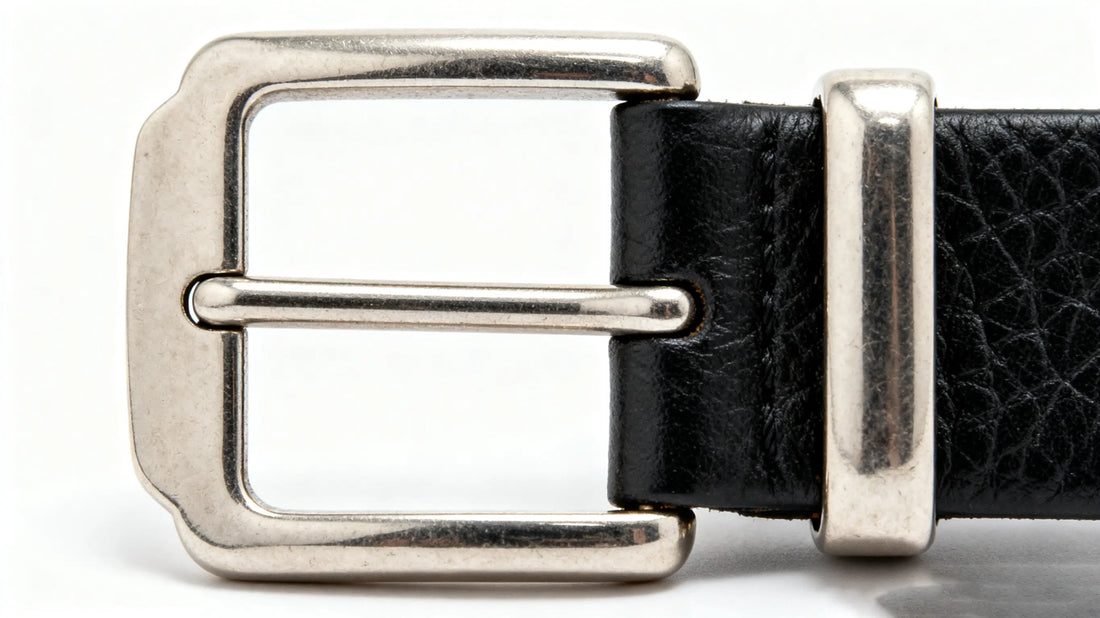
How Do Belt Buckles Work? The Mechanisms Explained
Share
Intro
Ever wondered how belt buckles actually work?
From classic pin buckles to modern ratchet systems, every buckle hides a simple yet clever mechanism.
In this guide, we’ll break down the parts, types, and science behind these small but essential accessories that keep your outfit secure and stylish.
Table of Contents
What Are the Main Types of Belt Buckles?
How a Traditional Pin Buckle Works
How Ratchet Belt Buckles Work
Inside the Automatic (Click) Buckle Mechanism
How to Adjust and Maintain Your Belt Buckle
Key Takeaways
Conclusion + Where to Buy
What Are the Main Types of Belt Buckles?

Belt buckles come in various designs, but most share the same purpose — connecting and adjusting the belt strap for a secure fit.
The main types of belt buckles include:
1️⃣ Pin (Prong) Buckle — the most common type, found in leather belts.
2️⃣ Plate Buckle — often seen on western or decorative belts.
3️⃣ Ratchet Buckle — uses a track system for micro-adjustments.
4️⃣ Box Frame / Clamp Buckle — secures by friction or tension without holes.
Each design serves different fashion needs — from rugged western styles to modern minimalist aesthetics.
How a Traditional Pin Buckle Works
A pin buckle, also called a prong buckle, consists of three main buckle parts:
Frame: the metal loop that holds the belt.
Prong (Pin): the moving bar that fits through holes.
Bar: connects the buckle to the belt strap.
⚙️ Mechanism:
When you thread the strap through the buckle, the prong fits into one of the holes.
This creates tension between the strap and frame, holding the belt firmly around your waist.
Why it works:
Simple mechanical leverage.
The prong acts as a pivot, resisting pull forces.
The bar ensures the strap doesn’t slide out.
👉 This timeless design has remained popular for centuries because of its durability and ease of repair.
How Ratchet Belt Buckles Work

Unlike traditional pin buckles, ratchet belt buckles rely on a track and latch system rather than holes.
⚙️ How It Works:
The belt strap has a row of small notches or teeth.
Inside the ratchet buckle, there’s a locking mechanism that clicks onto these teeth.
When you insert the strap, the latch catches the teeth one by one — producing the signature click sound.
To release, press the lever on the side to lift the latch.
Advantages:
Micro-adjustment precision (1/4 inch increments).
No holes to stretch or tear.
Sleek, modern aesthetic.
Ratchet systems are ideal for everyday wear and business outfits, offering the perfect mix of comfort and elegance.
Inside the Automatic (Click) Buckle Mechanism
An automatic belt buckle — also called a click belt — works similarly to ratchet belts but with added spring tension and magnetic locks.
🧠 How It Functions:
A spring bar inside the buckle creates pressure against the track.
When you push the strap in, the spring locks automatically.
A quick-release button disengages the latch smoothly.
Why it’s innovative:
Fast one-handed operation.
Always the right fit — no holes, no guesswork.
Sleek look suited for both casual wear and dress belts.
🔧 Pro Tip:
Keep the inner latch clean and lightly oiled — dust buildup can reduce locking efficiency over time.
How to Adjust and Maintain Your Belt Buckle
No matter the belt buckle mechanism, regular care ensures it lasts for years.
🪛 Adjustment Tips:
For pin buckles, add extra holes only if necessary — too many weaken the strap.
For ratchet belts, trim the strap from the buckle end for perfect length (never from the toothed side).
For automatic buckles, ensure the release lever moves freely — don’t over-tighten.
🧴 Maintenance Tips:
Wipe metal parts with a soft cloth after use.
Avoid water exposure — moisture causes rust in steel pins.
Condition leather belts every few months to keep them supple and prevent cracking.
Key Takeaways
Every belt buckle relies on mechanical tension or locking systems.
Ratchet belts and automatic buckles offer modern precision and comfort.
A well-designed buckle is not just functional — it’s a fashion statement.
Conclusion
From the classic pin buckle to the innovative ratchet system, understanding how belt buckles work helps you choose better, longer-lasting accessories.
👉 Explore our latest collections of Ratchet Belts and Leather Belts — where craftsmanship meets modern design.
FAQ
Q1: What is the most common type of belt buckle?
The pin buckle (or prong buckle) is the most common type, featuring a simple bar and pin mechanism that secures the strap through holes.
Q2: How does a ratchet belt buckle differ from a traditional one?
A ratchet belt uses a micro-track system and a locking latch, offering precise adjustments without holes.
Q3: Are automatic belt buckles durable?
Yes. Most automatic buckles use stainless steel parts and spring-loaded systems designed to last several years with proper care.
